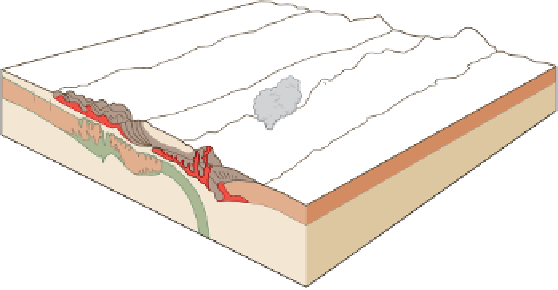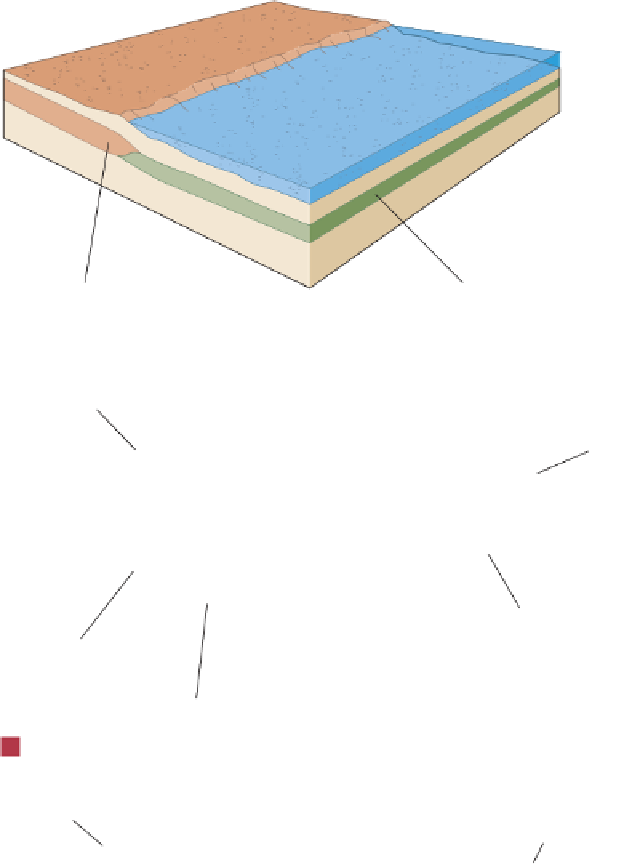Geology Reference
In-Depth Information
now realize that microplates and terranes also
played an important role in the formation of
Pangaea. Furthermore, they help explain some
previously anomalous geologic and paleonto-
logic situations.
◗
Figure 20.28
Ouachita Mobile Belt Plate tectonic model for deformation
of the Ouachita mobile belt.
North America
RESOURCES
Paleozoic-age rocks contain a variety of
important mineral resources, including
energy resources, metallic and nonmetallic
mineral deposits, and sand and gravel for
construction. Important sources of industrial
or silica sand are the Upper Cambrian Jor-
dan Sandstone of Minnesota and Wisconsin,
the Middle Ordovician St. Peter Sandstone,
the Lower Silurian Tuscarora Sandstone in
Pennsylvania and Virginia, the Devonian
Ridgeley Formation in West Virginia, Mary-
land, and Pennsylvania, and the Devonian
Sylvania Sandstone in Michigan.
Silica sand has a variety of uses, includ-
ing the manufacture of glass, refractory
bricks for blast furnaces, and molds for cast-
ing iron,aluminum, and copper alloys. Some
silica sands, called hydraulic fracturing sands,
are pumped into wells to fracture oil- or gas-
bearing rocks and provide permeable passage-
ways for the oil or gas to migrate to the well.
Thick deposits of Silurian evaporites,
mostly rock salt (NaCl) and rock gypsum
(CaSO
4
•2H
2
O) altered to rock anhydrite
(CaSO
4
), underlie parts of Michigan, Ohio,
New York, and adjacent areas in Ontario, Can-
ada. These rocks are important sources of vari-
ous salts. In addition, barrier and pinnacle reefs
in carbonate rocks associated with these evapo-
rites are reservoirs for oil and gas in Michigan
and Ohio.
The Zechstein evaporites of Europe
extend from Great Britain across the North
Sea and into Denmark, the Netherlands,
Germany, and eastern Poland and Lithuania.
Besides the evaporites themselves, Zechstein
deposits form the caprock for the large reser-
voirs of the gas fi elds of the Netherlands and
part of the North Sea region.
Other important evaporite mineral resources include
those of the Permian Delaware Basin of West Texas and New
Mexico, and Devonian evaporites in the Elk Point Basin of
Canada. In Michigan, gypsum is mined and used in the con-
struction of sheetrock. Late Paleozoic-age limestones from
many areas in North America are used in the manufacturing
of cement. Limestone is also mined and used in blast furnaces
for steel production.
Continental crust
Oceanic crust
a
Depositional environment prior to the beginning of orogenic activity.
(a)
North America
Gondwana
Continental crust
Continental crust
Oceanic crust
b
Incipient continental collision between North America and Gondwana began
during the Mississippian Period.
(b)
North America
Gondwana
(c)
c
Continental collision continued during the Pennsylvanian and Permian periods.
fragments (especially in Austria), as well as many other
bits and pieces of island arcs and suture zones. Not only
did these terranes and microplates separate and move away
from the larger continental landmasses during the Paleo-
zoic, but they usually developed their own unique faunal
and fl oral assemblages.
Thus, although the basic history of the formation of
Pangaea during the Paleozoic remains the same, geologists






















Search WWH ::

Custom Search